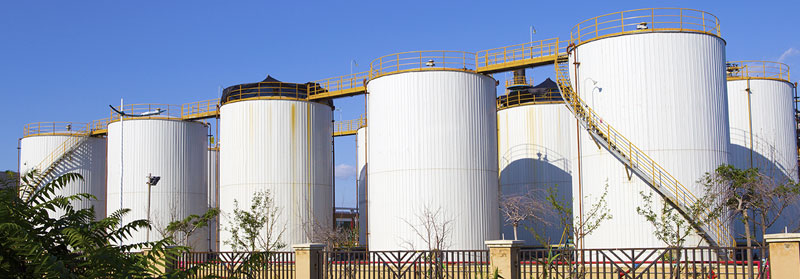Projects involving the painting and coating of storage tanks yield some unique challenges. The sizes of tanks vary widely, and so do their elevations. Most tank projects involve the need for fall protection. Virtually all of them involve confined space and all the risks associated with operating within them.
These are a few of the distinct concerns a contractor must account for before beginning a project involving storage tank painting and coating.

Entering confined spaces
Depending on the substance that occupied the tank before repainting, there is the possibility of a buildup of dangerous fumes near the bottom of the tank. Vapors from fuel or other chemicals, present in high enough concentrations, can be harmful or even fatal to crews working among them.
To protect against these hazards, air quality must be examined with a multi-gas monitor each time a crewmember is about to enter the tank. According to OSHA’s standards for the atmospheric testing of confined spaces, multi-gas monitors must be capable of testing for “oxygen, flammable gasses and potential toxic air contaminants that may be present as a result of the processes that take place in or around the confined space.”
Any job involving confined spaces also requires the presence of a “hole watch,” a crewmember whose sole responsibility is to monitor the entrance to the space and maintain constant radio communication with the crew inside. It is his duty to respond quickly in the event of an emergency.
Ventilation
Coatings themselves may also emanate fumes during the painting process. While applying them in open air this may not be cause for concern, but when applying coatings in a confined space the accumulation of these fumes can reach dangerous levels.
For this reason, it is necessary that crews spending protracted periods of time painting inside of a tank wear air-supplied respirators. In addition to these hoods, careful consideration must be given to air circulation.
It is essential that there is positive and negative airflow inside the confined space to ensure a fresh air exchange. The goal is to get roughly one complete cycle of fresh air into the tank every hour.
Fall protection
Tank painting jobs often require a fresh coat for both the inside and outside of the tank or tower. The need for fall protection on lofty, iconic water towers such as the ones we’ve painted at Alsip or Two Harbors is obvious. But even ground-level tanks like the one at Eglin Air Force Base rise multiple stories off the ground and necessitate safety systems be in place.
On jobs involving smaller tanks, staging systems are often constructed inside the tank itself. A T-system, consisting of two pick boards arranged perpendicular to one another and controlled by three motors, can raise crews to the appropriate working level. Crewmembers using the T-system should maintain a constant attachment to a safety line running from the ceiling to the bottom of the tank.
In the case of extremely large tanks, “door sheets” can be cut into the side of the structure. Man lifts can then be driven in through the opening, eliminating the need to construct a staging system. Once the job is mostly completed, the door is welded back onto the tank and coated last. This method, though often requiring the services of a subcontractor for cutting and welding, can be well worth it for the time that it saves.
A question of scale
Some projects, like the one we executed at the tank farm on the Point Loma Submarine Base, involve fields of many tanks. Jobs like these can represent a significant logistical challenge.
If it’s your job to choose to a contractor for a tank-painting job, you’ll want to make sure you choose one with plenty of experience. This will ensure that the contractor has the skills, equipment and staff to handle your job.


